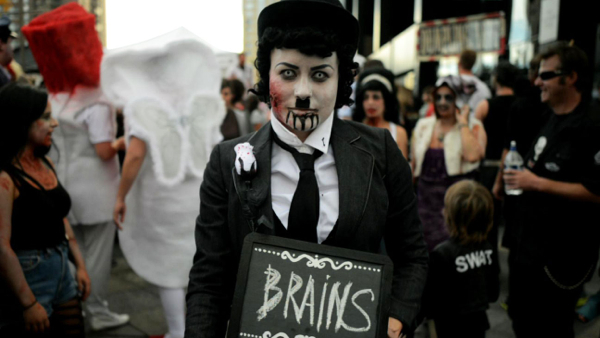Movie review by Greg Carlson
Pop culture chronicler Alexandre O. Philippe, whose tremendously entertaining 2010 documentary “The People vs. George Lucas” examined the devotion of “Star Wars” fan communities, applies a similar approach in “Doc of the Dead.” Philippe splatters his canvas with bloody, broad brushstrokes, painting a rapid-fire array of talking heads both noteworthy and obscure to contextualize the development of zombiphilia. On-camera interviews with authorities like George A. Romero, Simon Pegg, Tom Savini, Bruce Campbell, and Robert Kirkman are interspersed with liberal doses of movie clips from established classics and no-budget, backyard labors of love. Even zombies can’t be all things to all living people, however, and “Doc of the Dead” is best when it remains focused on the details of great genre films.
Zombie emperor Romero shares stories with his typical candor and humility, and “Doc of the Dead” would make a good double feature with Rob Kuhns’s “Birth of the Living Dead,” the 2013 film that focuses specifically on 1968’s seminal, game-changing “Night of the Living Dead.” Everyone in Philippe’s movie agrees that there is no single figure in the zombiverse more important to its evolution than Romero, and the filmmaker digs in to both “Night of the Living Dead” – with assists from co-screenwriter John Russo and actors Judith O’Dea and Russell Streiner – and Romero’s phenomenal 1978 sequel “Dawn of the Dead.”
The latter film is cited for a number of Romero’s brilliant genre contributions, including the perfect consumerist metaphor encapsulated in the film’s shopping mall setting, humorously described by Philippe via footage of rabid bargain hunters congregating outside a big box store on “Black Friday.” “Day of the Dead” is discussed primarily in the context of Sherman Howard’s fantastic performance as Bub, a turn that Pegg affectionately compares to Boris Karloff’s iconic interpretation of Frankenstein’s monster as a reminder that Romero can even be credited with realigning audience sympathies to allow us to root for the shambling flesh eaters – a rare occurrence in the canon.
Philippe loves the well-practiced one-liners of “The Zombie Survival Guide” and “World War Z” author Max Brooks, and “Doc of the Dead” outlines all kinds of scientific correlations, rules, and guidelines, including an informal referendum on the slow versus fast zombie debate. One of the movie’s most engrossing segments investigates the links between race, slavery, Haitian voodoo and pre-“Night of the Living Dead” interpretations of zombies on film. Philippe pauses to briefly acknowledge Victor Halperin’s influential “White Zombie” (1932), but skitters past other important titles. Brief mention is made of “I Walked with a Zombie” (1943), but Philippe pretty much skips international contributions, like the work of Italy’s Lucio Fulci and the “Blind Dead” series by Spaniard Amando de Ossorio.
Of course, running time makes it impossible to cover every important zombie movie, especially when surveying such a vast and varied genre, and Philippe can be credited for squeezing in mentions of many influential titles, from the brutal but comic fatalism of “Return of the Living Dead,” which popularized the notion of zombies as brain eaters, to the libido-driven sensuality of “Re-Animator,” in which Stuart Gordon inverts a central zombie tenet by, as producer Brian Yuzna indicates, giving the priapic Dr. Hill “a stronger idea of who he is” once he becomes a corpse. A case is also made that Pegg and Edgar Wright’s socially aware “Shaun of the Dead” closely follows “Night of the Living Dead” in importance, especially in terms of jumpstarting the contemporary wave of zombie popularity.
Among the most successful content creators of the current zombie apocalypse is “The Walking Dead” writer Kirkman, who notes, “I will plainly say that Bram Stoker is to Stephenie Meyer as George Romero is to Robert Kirkman.” “The Walking Dead” aside, the film’s final section speculates on the danger of zombie saturation, and Philippe lists a variety of cottage industries that have expanded production in the wake of zombie fever. Zombie video games, pub crawls, organized runs, immersive live action role play, television commercials, pornographic parodies, and survival preparedness gear manufacturers have all benefited from our ongoing fascination with the thin, mysterious veil between life and what happens to us after we die. That curiosity means the undead business is not likely to satiate its hunger anytime soon.
